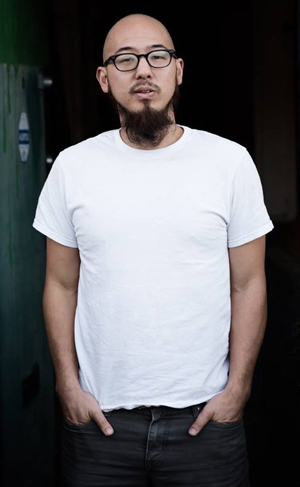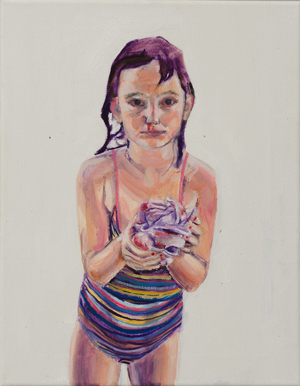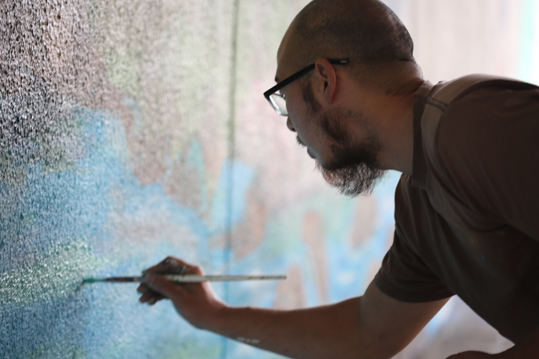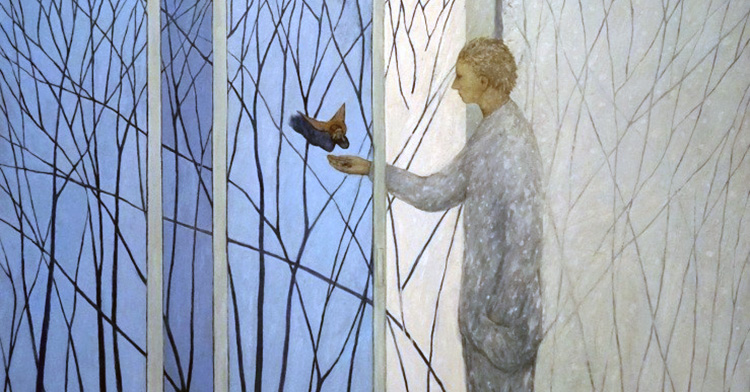Dave Young Kim has many identities. He is an MFA-trained painter, a street artist, a muralist, a Korean-American, a community activist, a former fraternity brother, a former gang member, a former biotech worker and a Christian.
He is currently working as a full-time artist in Oakland, where in addition to studio pieces, he creates murals that reflect the community.

Photo by ADZA
Born and raised in Los Angeles, Kim went to UC Davis, then worked in the biotech industry in San Francisco. He ended that “spiritually dry” time by quitting his job and going to work for five years at Regeneration Church, a multiethnic, multigenerational church in Oakland.
In 2012, he made another shift to pursue art and get a master of fine arts degree at Mills College.
In this interview, Kim talks about what it has meant to live out his calling as an artist and a Christian. The following is an edited transcript.
Q: Both artists and Christians use the term “calling,” but they mean somewhat different things. Do you think of your work as a calling, in either sense?
Both. I think that for everybody -- if you’re a writer, journalist, engineer, whatever it is that you do -- you live in and own a certain sphere in life/society/community that no other person can easily enter into. You live in that place, and the life in you shines. I think that is you living out your calling.
It’s not as grandiose as it seems. We don’t need that added pressure we put on ourselves or other people put on us. It’s really about confidence and doing the work it takes to cultivate a strong relationship with Christ and then those around you.
I definitely feel very secure and confident now in where I’m going and what I’m creating and putting all my energy into. So I am living out my calling.
I guess I haven’t used that term in a long time. That term makes it sound like it’s the thing, that it’s your purpose on this earth. So that makes it scary to commit to. But I’ve also accepted that I’m an artist.
Q: Your life, both personal and artistic, has been about crossing boundaries. What is important about that for you?
I think it stems from wanting to be a part of something that is bigger than myself. I didn’t feel a sense of acceptance in my childhood, and so maybe it’s a survival mechanism, this ability to enter into different worlds and be accepted into these worlds somehow. Eventually, I lost the need to ask permission from others. And that became the thing that’s allowed me to achieve the things I have and hope to in the future.

female divers in the Korean province of Jeju who
support their families by gathering seafood.
Photo by Dave Young Kim
And part of it, too, is trying to understand who I am as a Korean-American, which I explore in the documentary I’m working on, called “Interlaced.” So I don’t know -- it’s a little bit convoluted, a little bit complicated, but different extremes created the way I engage people and community.
Q: And where does your identity as a Christian fit into that?
Whatever world I enter into, I’m there; I can’t change who I am at the core of my being.
My identity as a Christian expresses itself as compassion and working with the community and trying to figure out how to best work within community conflicts.
To me, that’s like evangelism, right? It’s just doing what you do best and then being really who you are as a Christian in that place.
Q: Do you tend toward Christian themes explicitly in your artwork, or is the Christian part of your work more in the community-building aspect of it?
It’s definitely the community-building aspect. I think we’re supposed to live out our life based on our lived experience -- things that are valuable to us and things that make the most sense. And those are the things that we’re going to do at the highest level or the highest quality.
And so for me, those things are art, community, the streets, bringing people together, things like that. Immigration struggles, identity struggles -- those are things that I make the most work about.
Q: How does your work connect with the community? I know you are intimately involved in the neighborhoods of Oakland.
I don’t pretend to be a native, though I’ve lived here for about 10 years. I’m still learning about the community in an intimate way.
In terms of murals, they’re very public pieces of work. More people probably drive by some of my pieces in a day than will go to a museum in a month.
Before any work goes into the creation of the mural, there’s a lot of research. I’ll talk to people. I’ll go to the library and do some history research. I don’t want to plant a foreign object in the middle of a place. I work up a lot of imagery, and then once I feel like I have enough knowledge, I will go ahead and do the sketches.
In terms of non-murals, I just made some cutouts of Korean refugees for an art market in downtown San Francisco. It matters to me because I’m re-exploring my roots as a Korean-American right now.

Photo by Jenny Sharaf
Also, I think it’s relevant to the mass refugee situation in the world right now. It’s something that is on people’s minds.
I like to incorporate people’s stories, depending on the context. Another example -- I got a commission for a Thai restaurant. [The owner] wanted me to have freedom, but I also didn’t want to put, like, motorcycles in the middle of a Thai restaurant.
So I wanted to be aware of the context. He said growing up there were lots of rice paddies. That resonated with me, because we have these deep memories of home, certain iconic imagery associated with that. So I did rice paddies, and I did an outline of a home.

Photo courtesy of Dave Young Kim
And home is also something that I’m looking at, which ties into the refugee situation as well.
The concept of home -- the place we find that brings us comfort and peace physically, or the sweetest memory we have. For me, it’s the memory of me as a kid, loading up in my parents’ car with my drawing utensils and paper, riding in the back seat for an hour and a half to my grandfather’s motel in the middle of a desert, this oasis where we’d spend the day swimming in the pool and all my family would gather -- grandparents, aunts, uncles and cousins.
Everything about it, from the anticipation, the journey (an hour and a half is an eternity for a kid), to the location and the family. But with divorce, death, illness and infighting, that utopia is lost forever.

when he got in trouble with the police for throwing oranges
into a neighbor girl's pool party.
Photo by Dave Young Kim
So much of what I do is motivated by that memory. And ultimately, it’s just a longing to be connected with God and find the ultimate home.
I think with my work now, the concept I’m playing with, that’s what I want to do -- remind people that they have this idea of home, this desire to belong, this longing.
Q: What about the process for your murals? Do you invite people from the community to work with you, or is it more of your own personal artistic statement?
It is my personal artistic statement, but it does matter to me that people are part of it. I take in the stories. I talk to them.
There’s always a point in the beginning of a mural, before it gets super detailed, where there are simple things that people who don’t necessarily have the skill level could participate in.
And so I always welcome them to come and join, and I do feel it’s an important part of the process. And it’s part of who I am. It’s not something where I say, “Come out and help me paint.” But 90 percent of the time, it has happened.
I also do projects where it’s a group of artists in community, where we set out together to do it.
Q: What happens to the murals after you’ve finished them?
They’re left for the community. Unless it’s my immediate neighborhood, which the last couple of ones have happened to be, I leave it and walk away, and they have to live with it. That’s why it matters that it connects. It’s in their neighborhood, and it’s something they see every day.

Photo by Christian Janssen
Q: Has your experience shown that the community embraces the murals? That they take care of them?
Very few of my murals have been defaced. I’ve gone back periodically, and no one’s touched it. It’s cool. There’s a value to it, and sometimes the kids who have worked on the mural come over and share.
Q: You’re out there -- you’re outside, and you’re with people. Both through the process and with the resulting work of art, there’s more of an engagement than you’d get in the studio.
Yes, the studio is a very isolated place. It’s very lonely. That’s the opposite of a wall, where it’s almost a challenge to be focused, because there’s so much activity and so many people inquiring about what you’re doing.
In a sense, you live on that block, on that corner, on that wall, for a week or two. You see the same people walking the kids to school, then walking back without the kids, then later walking to pick up the kids and walking back with the kids. There’s a relationship, in a sense, that develops. It’s interesting.
Q: But it also can be dangerous. Your fellow artist Antonio Ramos was shot to death in September while painting an anti-violence mural. Has that changed the way you feel about working in the city?
No, it has not changed the way I feel about working in the city. I’m not afraid to continue painting the walls, and what I feel the murals do for the community and what they mean hasn’t changed. I’m just conflicted about -- it’s complicated. It is convoluted in my mind as I try to process it. It’s so mixed up with emotion and grief.

Photo by Vanessa Espinoza
Q: You were part of a group of people who finished the mural. I’m sure that was gratifying, but it doesn’t lessen the loss of your friend.
It doesn’t. We had a job to do -- we finished the mural, and we were kind of numb. I didn’t feel gratified. I had to will my muscles to do what they needed to do. We knew that it was still important to the city, to the community, so we had to work.
In the eyes of the public, this wall represents his legacy and his life. For the greater city, it does serve its purpose in giving people a sense of hope and showing people there’s a better way. And that’s what it’s supposed to do.














